Logistics companies rely on electronic document management systems (DMS) to streamline workflows across the supply chain. Key features such as digital storage, automated invoicing, and proof of delivery are essential for major players like DHL and FedEx. Document digitization reduces paperwork, cuts costs, minimizes errors, and improves process efficiency, making it vital for modern logistics operations.
Despite advancements, many logistics processes still rely on physical paperwork, including critical shipping documents such as the Bill of Lading, which is required in up to 40% of trade transactions. This reliance hinders using digital document processing and full digital transformation. Companies often delay the shift due to integration challenges and the complexity of modern business operations, leaving many systems only partially digitized.
In 2026, document digitization in logistics is no longer just about scanning and storage. The market is rapidly moving toward AI-powered document processing, electronic Bills of Lading (eBL), automated customs clearance, and ESG-driven reporting. Regulatory pressure from the EU, IMO, and international customs authorities now makes real-time digital document exchange a mandatory standard rather than a competitive advantage.
Main transportation sectors and the importance of document digitization
Talking about document digitization, we briefly examine the relative significance of various modes of supply chain transport and their impact on the flow of transportation and logistics documents. There is no doubt that this is the area where the seamless movement of business documents plays a crucial role. We now have several segments of transportation that are crucial for domestic economies and are vital to keeping flexibility across various supply chain channels:
Maritime transport
Documents in maritime depend on three parties, and without document digitization, this process would be very slow and inefficient. Each party creates a document source that helps control the transport through the sea, ocean, and even freight transport on inland waterways, such as rivers or canals. These parties are:
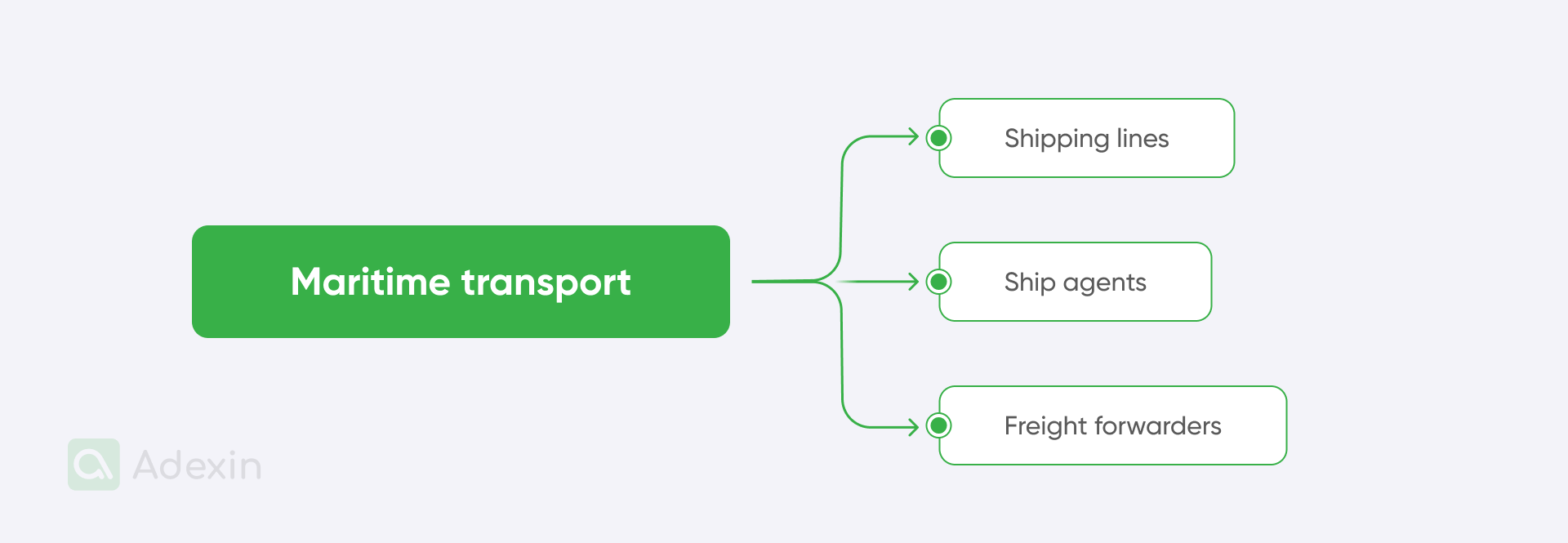
Shipping lines. Shipping lines are the owners and operators of the various types of vessels in their fleets. Their primary role is to provide the physical resources necessary to transport cargo safely and efficiently by waterways. You may be already dealing with them in your daily communication and have already received several emails with outstanding PDF scanned documents, such as certificates of origin (COO), waybills, and others.
Ship agents. Ship agents offer essential services to shipping lines in ports of call. These agents perform a wide range of critical tasks for the supply chain on behalf of the shipping lines, which also involve handling crucial documents. They might be interested in custom procedures, feeding your Operations Support Group department with Customs documents and invoices.
Freight forwarders. Freight forwarders, also known as transport management companies, oversee the entire freight journey from start to end. They provide end-to-end solutions for the supply chain. They handle documents, coordinate modes of transport, manage customs processes, and organize port services. They may help you connect more than one way of shipping goods and will provide you with tons of various shipping documents.
An excellent example of maritime transport is all that happens in the Port of Antwerp-Bruges in Belgium, one of the largest in Europe. This port unquestionably handles a large number of container shipments via vessels that are shipped through the various waterways. The Port of Antwerp-Bruges in Belgium is also an excellent example of supply chain models that underpin logistics and shipping operations worldwide. These shipping operations generate a substantial volume of documents, often transmitted from one vessel to other ports and vice versa, by using typical USB memory sticks passed among seafarers.
Since 2024–2026, the global maritime industry has been rapidly transitioning to electronic Bills of Lading (eBL) supported by the Digital Container Shipping Association (DCSA). Platforms like Bolero, essDOCS, CargoDocs, and integrated port community systems are replacing USB-based document transfers. eBL adoption significantly reduces fraud risks, document latency, and cargo release delays while enabling near-real-time trade finance automation.
So, at this point, there's a significant reliance on digitally scanned documents stored on these types of hardware, but maritime transport often still relies on paper documents. What directly helps in handling this process are document management system solutions, especially those dedicated to transportation. We can conclude that no matter which transport mode you choose within your supply chain, with DMS digitization software, you'll have all-in-one access to your transportation scanned documents in one place. You can also minimize the risk of document loss by passing them in paper format, as mentioned, only on USB memory sticks.
Air transport
Opposite to maritime transport, air freight involves distinctly different legal regulations based on the various types of aircraft, from airplanes to helicopters, each requiring specific documents. Most of today's regulations are overseen by the International Air Transport Association (IATA), which also enforces strict laws regarding the transportation of dangerous goods (DGR). Similar to maritime transport, air freight involves three major parties in the document flow that need to be exchanged among supply chain stakeholders:
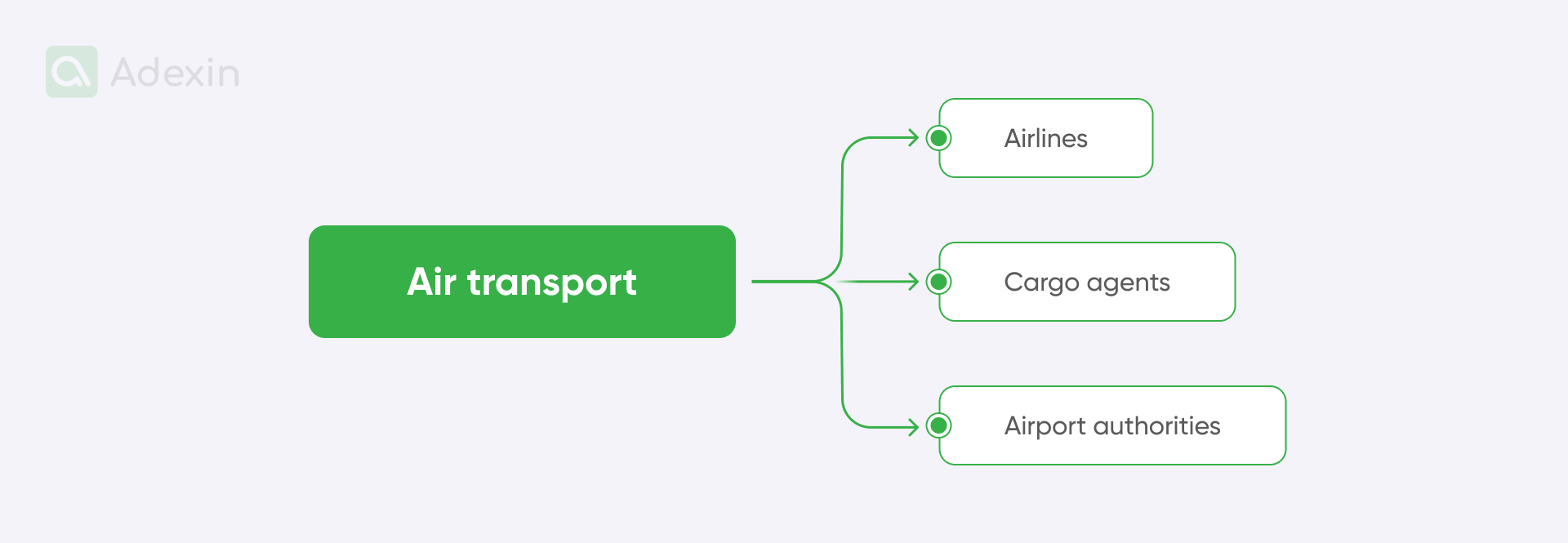
Airlines. In the case of airlines, it's about companies that own and operate aircraft for passenger and cargo transport. They specialize in services such as low-cost supply chain operations or air freight. This specialization also gives rise to a multitude of documents exchanged between ground personnel at the airport and beyond. Eventually, these documents, such as Bills of Lading, can end up on your desk in your warehouse. Everything is highly interconnected.
Cargo agents. Cargo agents, licensed by IATA, handle airfreight on behalf of clients. They must comply with IATA standards, maintain insurance, and issue airway bills (HAWBs) and other transport and logistics documents. The challenge with IATA regulations is that they change annually. Your personnel need to stay updated to avoid mistakes on documents, often requiring them to check the 1,000-page IATA regulation book necessary for labeling shipments. Simply put, air freight shipments entail a multitude of documents, which pass from hand to hand throughout the supply chain operation cycle.
In 2026, the IATA e-AWB standard will have become the default rather than the exception. AI-powered document validation now automatically checks airway bills, dangerous goods declarations, and packing lists for compliance before cargo even reaches the airport. This reduces human error, speeds up customs pre-clearance, and minimizes costly cargo holds and rejections.
Airport authorities scanning. Airport authorities are the owners and operators of airport infrastructure, which also involves a substantial volume of documents that must be provided to air carriers. These documents include information on how cargo is stored before it is loaded onto an aircraft. Logistics personnel on the ground need to know what they are dealing with before loading cargo and what to do once the shipment arrives at its destination airport.
Regarding air freight, the quality of service must be the highest priority. It's all about avoiding compliance with transportation rules. Therefore, it is crucial to provide the highest quality of documents when they pass from one party to another, especially for hazardous cargo (DGR). To prevent plane crashes like the case of UPS Airlines Flight 6 on September 3, 2010, caused by an onboard fire, it's evident that exchanging high-quality digital documents among key parties in the supply chain and logistics is essential for ensuring cargo and people's safety.
The world's largest airports, such as Denver International Airport (DEN), handle approximately 235,611 metric tons per year, directly highlighting the significance of a streamlined document digitization flow. This is a huge amount of paperwork for logistics personnel who operate in warehouses on airport premises or coordinate deliveries from outside locations. The solution to these challenges lies in professional digital document quality management software, which unquestionably secures the entire document scanning flow with high-quality data. This solution is not exclusive to air freight, good-quality DMS software can be applied in any industry where top-quality data on shipments is essential to avoid costly issues.
Rail and intermodal transport document digitization
Rail transport for the cargo combines different intermodal equipment that is selected regarding cargo requirements. There are a variety of independent standard documents that can be used directly for transportation purposes, and the type of modal transport can provide a basis for drawing up a new record. Most of the shipments for this transport are handled in containers or by trailers, which are later replaced on the trucks in the road transport. All that depends on supply chain planning. Here are two elements that are important for this kind of transport, these are included as follows:
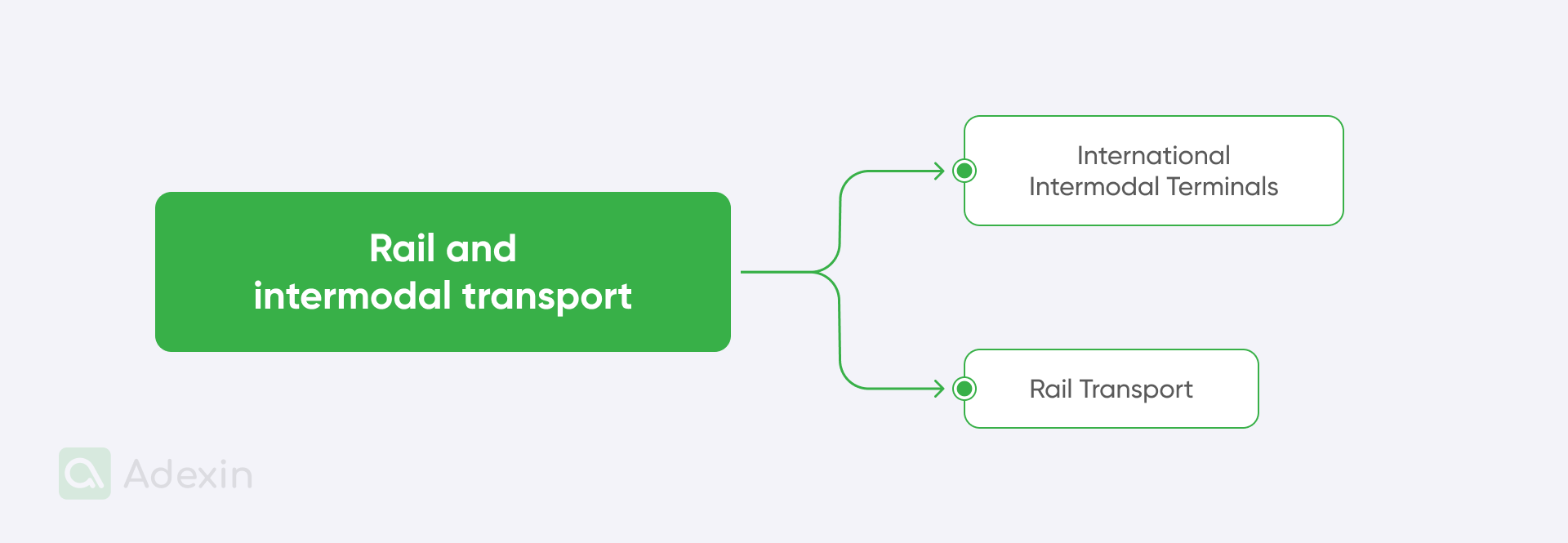
International intermodal terminals. These are key road-rail interchange points within the rail industry dedicated to cargo. They often include warehouses, distribution companies, and consolidation services for general cargo and freight. This forms an interconnected network coordinated by supply chain operations. Documents flow significantly as these terminals are connected to ports and road freight, resulting in various documents for various transport purposes.
Rail transport. Carriers that provide rail transport utilize public rail infrastructure for various transport modes and cargo available through the supply chain. This includes cargo in enclosed boxcars, refrigerated wagons, flat wagons, tankers, containers, and car transporters. Various documents come into play, specifically for stakeholders closely associated with ground freight.
Rail transportation plays a significant role in domestic economies, and in various scenarios, rail and intermodal transport offer the most efficient means of handling shipments. As intermodal transport combines both road and rail transport, this presents a significant logistics challenge. A great example is the European rail network via the Channel Tunnel. This kind of model requires a wide range of shipping and customs documents.
In 2026, rail and intermodal operators increasingly rely on IoT sensors and digital twins to synchronize physical cargo movement with real-time document flows. Each container movement automatically triggers document updates inside the DMS, enabling predictive tracking, automated ETA adjustments, and compliance verification without manual intervention.
There's no doubt that document digitization in rail transportation, using shipping documents digitalization software, can effectively remove the constraints associated with this form of transport in the supply chain. It is important to remember that this solution isn't exclusive only to rail and intermodal transportation. But below we take a look at the blockchain-based DMS system for eTEU, which we developed as a custom solution for various types of transport widely used throughout the supply chain, supporting transportation operations in many cases, such as road transportation.
Road freight transport
This form of freight transportation is the most popular, mainly because it is the final stage of handling shipments before they reach their destination in warehouses or distribution centers. Of course, road transport with trucks and trailers goes far beyond and is the core element of the supply chain. Road transportation of goods includes a variety of shipping operations dependent on logistics, with trucks and trailers as the main types of vehicles. These vehicles can transport cargo from airports and ports, carry raw materials from mines, deliver windmills to power plants, and much more. The range of shipments is highly diverse, with no limits. Nevertheless, shippers and carriers must efficiently manage documentation tailored to the specific cargo being transported. Three specific elements can affect the required documents in road transportation:

Main types of vehicle bodies. Choosing the right vehicle body type depends on operational and load requirements. Different body types offer unique advantages and disadvantages based on the tasks and cargo resulting from planning in the supply chain. They may also require unique documents and approvals to participate in road traffic regarding large-volume goods transport.
Types of operation. The broad spectrum of supply chain operations matches a wide range of tasks, such as long-distance transportation involving fast delivery of heavy loads. Road trucks with multiple trailers are very common in some cases as a solution for the supply chain. Drawbar combinations offer additional cargo space for light but bulky loads. Special trailers handle medium-weight and volume loads.
Load types and characteristics. Cargo characteristics are crucial to transportation planning, where the first stage is shipping from the logistics warehouse. A shipment may contain light or bulky cargo that requires vehicles with high volume relative to their weight. Heavy loads require specialized vehicles, and mixed loads present weight distribution challenges. Valuable cargo requires secure vehicles with anti-theft features.
In 2026, electronic CMR (eCMR) will become the standard across the EU and will expand globally. Drivers now capture documents using mobile apps with AI-based image enhancement, automatic validation, and real-time synchronization with ERP and TMS systems. This enables instant proof of delivery (POD), faster invoicing, and minimized dispute resolution cycles.
Besides the aforementioned characteristics of consignments, there are also other ones, such as bulk liquids and powders, which require specialized tankers. These are mostly dangerous goods that require extra precautions to prevent chemical reactions and electrical hazards. As we've previously mentioned, in the context of air freight transport, supply chain planning must comply with transportation law, resulting in a substantial volume of documents.
There is no single example to illustrate the types of documents required in transportation and logistics, but all of them should be digitized. Adopting a document management system (DMS) for transportation and supply chain operations can revolutionize your business and how documents are handled. You can also support your truck fleet by providing real-time assistance on the road, offering all the data to your personnel whenever they need it. Digitizing documents can help you push the boundaries of your business beyond the typical problems associated with paperwork.

Why do you need digitized documents?
As we said, manually completing shipping documents can be troublesome, and the process can involve several complicated steps. Whatever documents we need to consider, a simple typing error, missing documents, or incorrect values filled in can cause steadily increasing problems that can develop into more serious and expensive issues.
We can mention delays with unloading trucks and containers here due to incorrect shipping codes added to customs documents. In such a case, a company can receive a fine from the customs office, not to mention contractual agreement payments for delays.
We outlined actual key issues with document management on transportation, logistics, and supply chain. Here are some of the primary issues associated with document-related challenges:
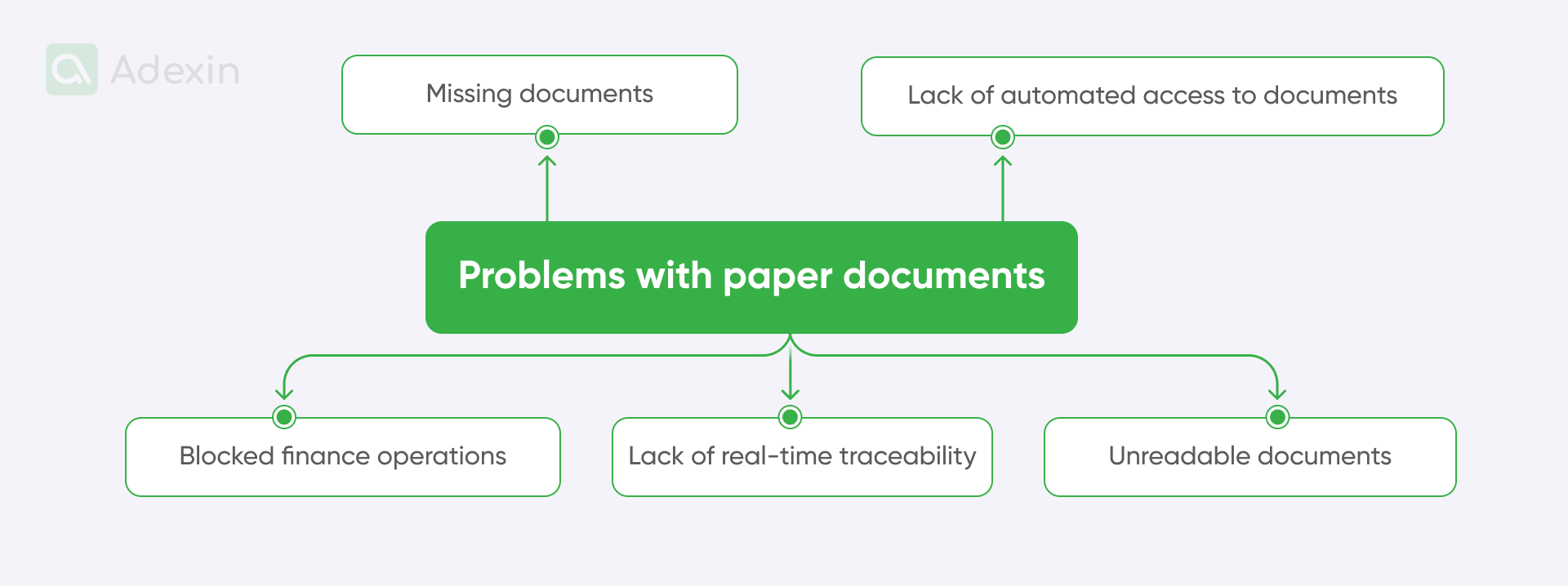
Missing paper documents
What makes work in transportation and supply chain oppressively difficult is the missed, mixed, or switched shipping documents on the pallets. Hours pass before your team can process the shipment for the warehouse stock. This is not the sole reason, but regardless of the cause of the missing paperwork. In the end, everything comes back to transport administrators, who must provide document scanning copies via email or reprint them.
Unreadable documents
Unfolding other challenges in transportation and supply chain, we bring into closer focus issues related to the readability of transportation documents. How often have you seen this growing frustration when your people cannot read documents or need to rewrite data from them manually, yet they are obliged to provide fast feedback because trailers are waiting for unloading at the logistics warehouse? Implementing document digitization can eliminate these issues.
Blocked finance operations
Smooth financial document flow in transportation and supply chain shortens the time to invoice. The document management in transportation requires various confirmations, from freight invoices to ocean freight documents. The range of papers is extensive, especially about international shipping. You need them on time to get paid.
Lack of real-time traceability
Every day, issues in logistics and supply chain document management are related to the lack of traceability. This results in missing packages. In many cases, it also resulted in lost pallets, which were unloaded in the wrong warehouse and ultimately led to lower customer satisfaction. Most of these problems happen when truck drivers don't have the right digitization tools.
Lack of automated access to documents
The major problem in today's logistics document management is caused by poorly located sources of information. Low access to documents or a lack of integration of ERP, warehouse management system (WMS), and TMS can lead to data inconsistencies and errors, and often prevent the delivery process from moving forward. Your business is frozen, and it costs a lot of money.
In 2026, cybersecurity has become a critical aspect of document digitization in logistics. Hybrid paper-digital workflows create unexpected vulnerabilities as documents are frequently photographed on personal devices, forwarded through unsecured messaging apps, or stored in unregulated cloud folders. These unmanaged data flows significantly increase the risk of leaks and compliance violations. Regulators worldwide now consider poor control over document exchange a major data protection breach, and companies face growing fines for improper handling of transportation and customs documentation.
Also, one of the important issues with document management in the logistics and supply chain industry is that many companies are still far from getting shipping documents done right, as they don't use DMS. To help with those logistics, FedEx, like many other logistics companies, has created a complete commercial invoice guideline to explain to companies how to process the completion of shipping documents.
Why do we need this? We need it because the process is so complex and, at the same time, important that your shipment can be refused only because of incorrectly filled documentation. Refusing shipments in international eCommerce shipping is common due to inaccurate customs documents and commercial invoices. This was even highlighted by Chris Hodge, a Manager from FedEx, in one of the presentations at eCommerce Berlin 2024.
Not many of you may know, but customs offices worldwide are setting up full lists of error codes that help identify certain document mismatches, duplicated records, invalid transport means, mismatches between transport numbers between DP and AT, and many others. This complexity is much broader; therefore, keeping documents accurate is crucial. This error code list would not be needed if there were more integration between customs and shippers, but this is another story. However, it can be achieved with efficient document digitization and the right DMS.

Starting with document digitization software
What is the basis of document digitization? Yes, you need scanning software, but this software has its most important feature that allows you to quickly transform your paperwork into digital assets that can be freely exchanged throughout the company's departments. We're talking here about optical character recognition (OCR) for your transportation documents.
This basic feature can use a camera to recognize pieces of text and convert them into a digital file format. Simple as it is, you may need great scanning software developers to help you make it real, or you can just use some existing system to handle documents. This is how you can make a choice between custom software development for your documents and an off-the-shelf solution.
In many cases, it is easy to say, let's use something that is already on the market and has its users. But it often boils down to higher expenses and, more often, double work. What we're talking about here is that off-the-shelf software might be easy to access, maybe a bit cheaper, but in most cases, it will not cover your complex business needs.
As we mentioned above, you may need OCR functionality, proof of delivery (POD), and a virtual signature embedded as a feature of your document management system. However, off-the-shelf solutions will have simple integration problems, as virtual signature features may be missing. So your customer will not get all the data in one place. Your truck drivers will not be able to scan documents and share them with you when it's needed. That was just one of the many examples of how your life can get more complex with no custom development.
In 2026, the basis of document digitization is no longer just OCR. The modern systems that Adexin works with rely on intelligent document processing (IDP), which combines OCR, machine learning, and AI-based semantic recognition. IDP automatically classifies document types, validates business data, detects anomalies, and integrates structured information directly into ERP, TMS, and financial systems without human input.
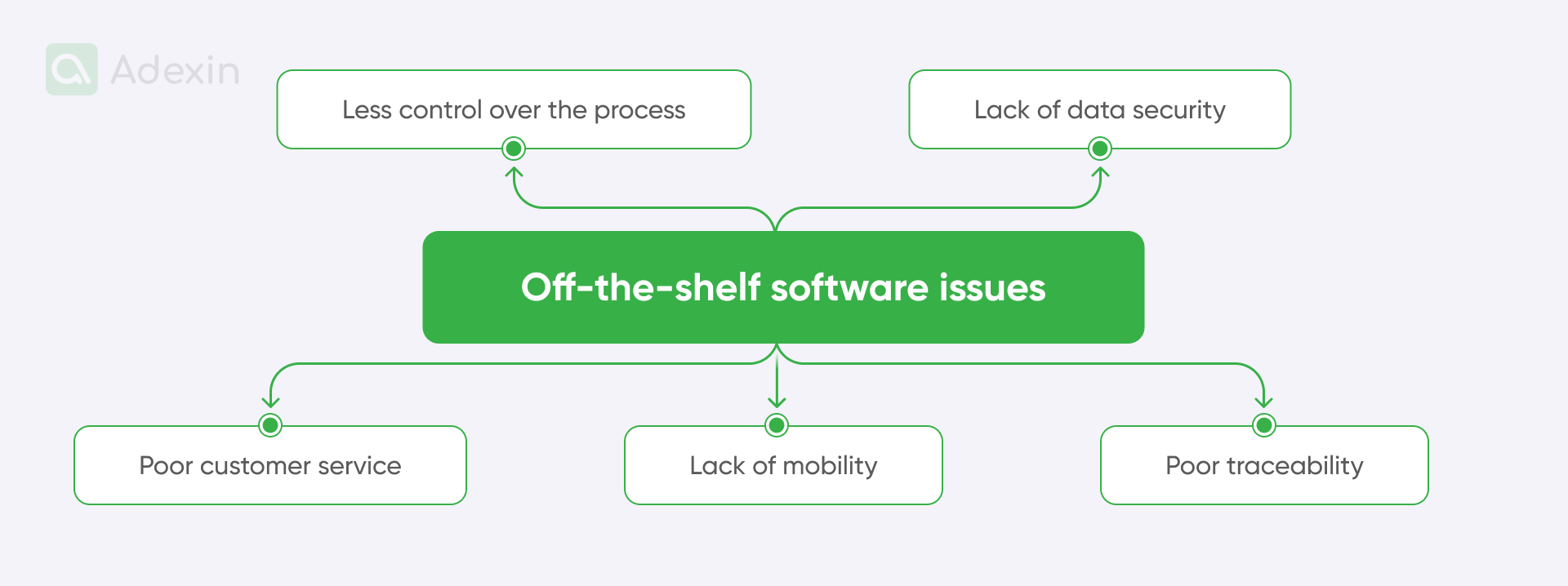
Off-the-shelf solutions can reveal many problems:
Less control over the process
Poor customer service when it comes to handling issues
Lack of data security (you never know who manages your sensitive data)
Lack of mobility (most of the services don't provide mobile apps)
Poor traceability
Another important challenge that becomes more visible in 2026 is the growing dependency on off-the-shelf platforms, which often leads to vendor lock-in and limited control over company data. Many logistics businesses discover that they cannot freely export or migrate their documents, retrain AI models, or modify automation workflows to match their operational needs. As a result, their ability to customize or scale AI-driven processes is restricted, making it difficult to adapt document digitization tools to new regulations, transport requirements, or industry standards.
What you really need before starting with document digitization in logistics, transportation, and supply chain is to find experts who understand the industry from the field of software development. They will know how to integrate DMS with the right features and connect it to your existing system. Yes, that's true. Document digitization systems can be just an additional functionality to your existing systems, so you don't need to rebuild your organization and bring chaos to operations. With custom scanning software development, you can transform your business step by step, ensuring sustainable growth.
What are the features of document digitization by a DMS solution?
When you've already decided to consider professional document digitization software, it's worth knowing what kinds of features you can find. We have selected some of them right here to help you understand their value. These can turn into real gold in each industry, whether it's supply chain, logistics, transportation, or other side operations such as financials, administration, or people management.
Of course, there are many features, and you may not need all of them at once. It all depends on your business documents and operational requirements. We have selected 5 key features of paper document scanning software to make it even easier to help you make the right choice. You can always reach out to us and learn about scanning software and document management in various industries.
6 ultimate benefits of document digitization for document management
In 2026, digital document management will also play a growing role in meeting sustainability and financial control requirements. Modern DMS solutions support ESG compliance by automatically extracting environmental data from transport documents and generating carbon reporting insights needed for audits and regulations. At the same time, AI-driven analytics help companies optimize operational costs and detect anomalies or potential fraud in documentation, improving financial transparency and reducing risks across logistics workflows.
Document digitization provides great benefits to a company that can simplify transportation, logistics, and supply chain operations. So, you can consider it much easier to determine what is actually relevant and adds value to your transportation business.
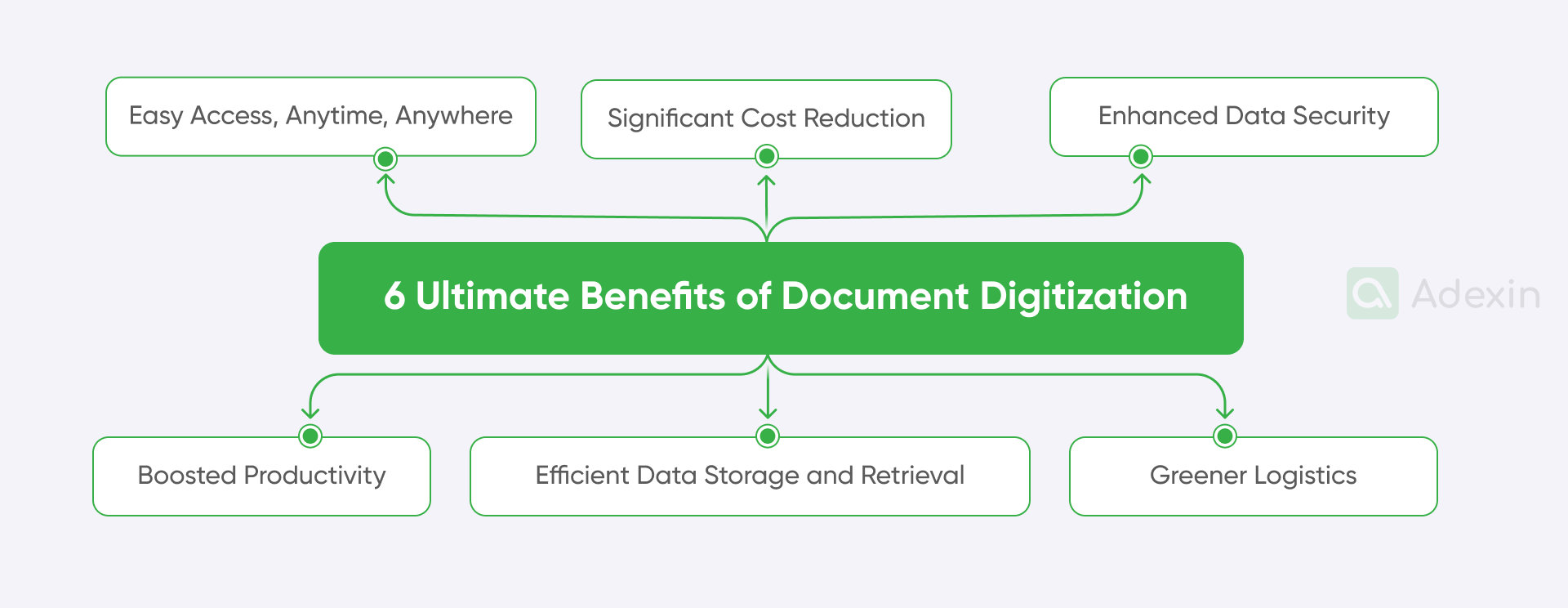
Here are these benefits:
Easy access anytime anywhere. Quick access to critical documents is essential for efficient operations. Digital document management allows you to retrieve necessary information instantly, improving decision-making and accelerating processes.
Significant cost reduction. Eliminating paper-based processes can reduce operational costs. Digital document management reduces printing, storage, and administrative expenses, significantly saving costs.
Enhanced data security. Protect sensitive information with robust security measures. Digital systems offer advanced encryption and access controls to safeguard your data from unauthorized access and potential breaches.
Boosted productivity. Streamline document management workflows and reduce administrative burdens. Automating tasks and improving document organization can boost productivity across your entire organization.
Efficient data storage and retrieval. Manage large volumes of data effortlessly. Digital systems efficiently store and retrieve documents, ensuring easy access and compliance with regulations.
A greener logistics and sustainability. Reduce paper consumption and waste to contribute to environmental sustainability. Digital document management promotes eco-friendly practices, making your operations more sustainable.
Need help with document management systems development?
Learn how we can boost your business processes
Explore moreDocument scanning and digitization software: case study experience
As a leader with extensive experience developing digital solutions for logistics and supply chains, we also have a proven track record in building DMS systems. One of the examples we're highlighting today is the shipping document management platform for eTEU.
What is eTEU? It is a digital platform that streamlines document generation, editing, and transfer via an easy-to-use management system. Unlike many repository-like solutions that simply provide a space for data storage, eTEU delivers an additional layer of operational transparency and enhanced security.
The case with eTEU involved businesses that don't use the same file formats, causing their documents not to work together. This created problems, especially when multiple people, such as salespeople or carriers, were involved in shipping.
A good example is the Bill of Lading, which, according to McKinsey research, can account for 10-30% of total trade documentation costs. Switching to a digital Bill of Lading could save carriers over $6 billion annually. This was a similar case we aimed to solve for eTEU.
Here's a summary of what we did for them:
Standardization and compliance. Ensured adherence to industry standards and regulatory requirements, particularly those set by The International Group of Protection and Indemnity Clubs.
Blockchain integration and document processing. Implemented blockchain technology to secure data transfers, create an immutable audit trail, and speed up document exchange.
Database migration optimization. Utilized a new tool to streamline the migration process and track database history.
API documentation with Swagger. Enhanced API documentation accessibility for developers and machines.
Transition to GraphQL. Accelerated front-end development and streamlined data delivery.
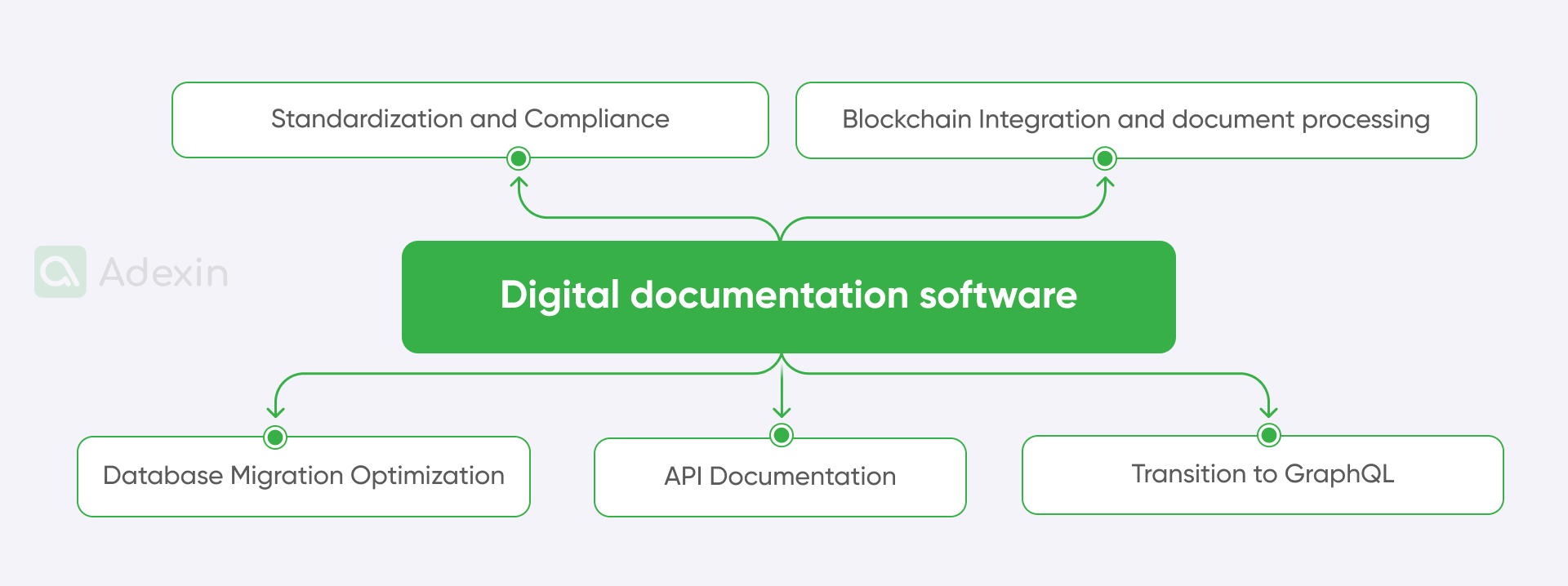
Overall, the solution focused on:
Security. Protecting sensitive data through blockchain technology.
Efficiency. Streamlining document generation, transfer, and tracking processes.
Compliance. Adhering to industry standards and regulations.
Scalability. Building a flexible infrastructure to accommodate future growth.
User experience. Enhancing the user experience with a user-friendly interface and efficient workflows.

According to 2025 global compliance analytics, over 93% of logistics companies faced at least one financial penalty related to documentation errors, customs mismatches, or delayed digital submissions. The root cause in most cases remains fragmented document systems and a lack of end-to-end data integration.
How much does document digitization software cost?
In 2026, the cost structure of DMS projects is increasingly influenced by AI model training, data labeling, cybersecurity compliance, and cloud infrastructure scalability. These components now account for up to 35–50% of total project budgets in advanced implementations.
That's the most important question. No one wants to spend a massive amount of money on document digitization. We have evaluated the factors that validate the costs of the custom software versus off-the-shelf. Here below, you can read the cost fluctuation of custom software development and off-the-shelf, basically depending on the size of the business:
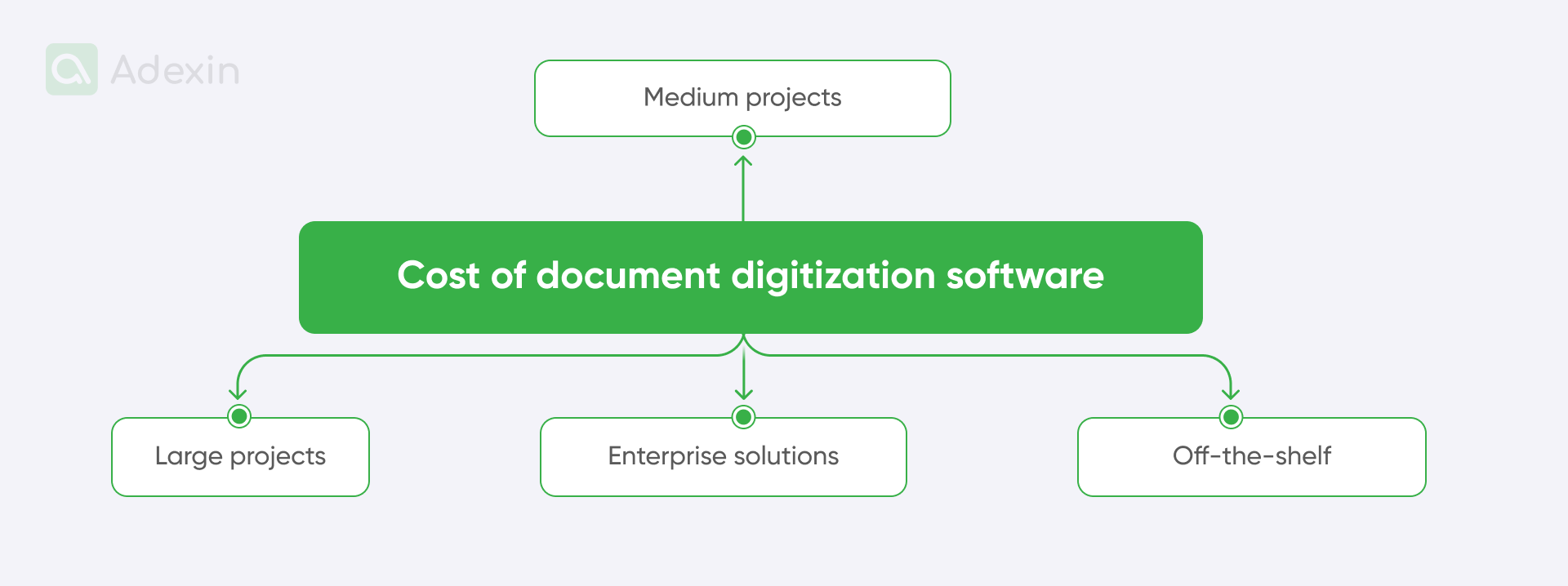
Medium projects
This category offers a different perspective. If you want to take your document digitization software to the next level with more features, prices can vary significantly. It may encompass more complex web applications, e-commerce platforms, or mobile scanning apps with moderate features. Prices may fall within the range of $50,000 to $250,000.
Large projects
Now, we're delving into complex digitization software solutions at an enterprise level. These are applications and systems with advanced features that fit into this category. Prices can vary widely and often exceed $250,000, reaching into the millions. Price fluctuations often depend on factors like the number of users and whether it includes on-premises installation or other options.
Enterprise solutions
In this category, we encounter large and highly complex systems with extensive customization and integration. You may require something highly specific to your business to gain a competitive edge. Prices, in this case, can vary significantly and are typically higher than those for large projects.
Off-the-shelf solutions
This option typically comes at a lower price point, but you don't own the software, and it may not accommodate special requests. You also do not have control over your data. You share everything your company possesses with unknown parties. For a good document digitizing software, prices usually range up to $1,000 for enterprise solutions. However, it's important to note that such software may not seamlessly integrate with your existing systems.
Need a digital transformation to develop your project?
Learn how we can boost your business processes
Explore moreFinale takeaway
One of the most interesting trends in recent years is that small businesses and startups stand to gain the most from the ability to call in specialized help on an as-needed basis. This is a kind of norm today, and it also refers to the whole spectrum of services offered by custom software development companies to transportation, logistics, and supply chains. The matter is that using digital tools for revenue growth, including boosting export capabilities for logistics companies, is on the rise. This fact is confirmed by the latest analysis made by McKinsey, where the transportation potential towards automation is about 66% on average, which is in the top 5 areas.
Looking at our material on electronic document management software, we may say that companies are also extensively gaining a competitive advantage by investing in DMS systems. Document Digitization and automation of document management make logistics work smoothly. It is an area where we at Adexin have truly excelled over the years. We have helped companies put together processes and make their operations seamless. Do you want to know more about it? Get in touch with us and learn how to find a partner on your digital journey.


